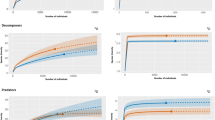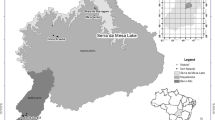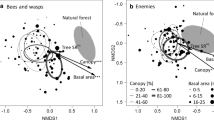Abstract
Timber tree plantations are considered for rehabilitating forest biodiversity in the tropics, but knowledge on determinants of faunal diversity patterns in such human-modified forest landscapes is scarce. We quantified the composition of beetle assemblages on three native timber species (Anacardium excelsum, Cedrela odorata and Tabebuia rosea) planted on former pasture to assess effects of tree species identity, tree species diversity, and insecticide treatment on a speciose group of animals in tropical plantations. The beetle assemblage parameters ‘abundance’, ‘species richness’, ‘Chao1 estimated species richness’ and ‘Shannon diversity’ were significantly reduced by insecticide treatment for each tree species. Shannon diversity increased with stand diversification for T. rosea but not for A. excelsum and C. odorata. Species similarity was highest (lowest species turnover) between beetle assemblages on T. rosea, and it was lowest (highest species turnover) for assemblages on insecticide-treated trees of all timber species. Considering trophic guilds, herbivorous beetles dominated on all tree species and in all planting schemes. Herbivores were significantly more dominant on T. rosea and C. odorata than on A. excelsum, suggesting that tree species identity affects beetle guild structure on plantation trees. Insecticide-treated stands harbored less herbivores than untreated stands, but exhibited a high abundance of predator beetle species. Our study revealed that even young pasture-afforestations can host diverse beetle assemblages and thus contribute to biodiversity conservation in the tropics. The magnitude of this contribution, however, may strongly depend on management measures and on the selected tree species.



Similar content being viewed by others
References
Adis J, Lurina YD, Montgomery NDGG (1984) Arthropods from the canopy of inundated and terra firme forests near Manaus, Brazil, with critical considerations on the pyrethrum-fogging technique. Stud Neotrop Fauna Environ 4:223–236
Barbosa P, Segarra A, Gross P (2000) Structure of two macrolepidopteran assemblages on Salix nigra (Marsh) and Acer negundo L.: abundance, diversity, richness, and persistence of scarce species. Ecol Entomol 25:374–379
Barbosa P, Hines J, Kaplan I, Martinson H, Szczepaniec A, Szendrei Z (2009) Associational resistance and associational susceptibility: having right or wrong neighbors. Annu Rev Ecol Evol Syst 40:1–20
Barone JA (2000) Comparison of herbivores and herbivory in the canopy and understory for two tropical tree species. Biotropica 32:307–317
Bascompte J (2009) Disentangling the web of life. Science 325:416–419
Basset Y (1999) Diversity and abundance of insect herbivores foraging on seedlings in a rainforest in Guyana. Ecol Entomol 24:245–259
Basset Y, Aberlenc HP, Barrios H, Curletti G, Berenger JM, Vesco JP, Causse P, Haug A, Hennion AS, Lesobre L, Marques F, O’Meara R (2001) Stratification and diel activity of arthropods in a lowland rainforest in Gabon. Biol J Linn Soc 72:585–607
Basset Y, Novotny V, Miller SE, Kitching RL (2003) Arthropods of tropical forests. Cambridge University Press, Cambridge
Basset Y, Mavoungou JF, Mikissa JB, Missa O, Miller SE, Kitching RL, Alonso A (2004) Discriminatory power of different arthropod data sets for the biological monitoring of anthropogenic disturbance in tropical forests. Biodivers Conserv 13:709–732
Basset Y, Missa O, Alonso A, Miller SE, Curletti G, De Meyer M, Eardley CL, Lewis OT, Mansell MW, Novotny V, Wagner T (2008) Choice of metrics for studying arthropod responses to habitat disturbance: one example from Gabon. Insect Conserv Divers 1:55–66
Bremer LL, Farley KA (2010) Does plantation forestry restore biodiversity or create green deserts? A synthesis of the effects of land-use transitions on plant species richness. Biodivers Conserv 19:3893–3915
Brockerhoff EG, Jactel H, Parrotta JA, Quine CP, Sayer J (2008) Plantation forests and biodiversity: oxymoron or opportunity? Biodivers Conserv 17:925–951
Catterall CP, Kanowski J, Wardell-Johnson GW (2007) Biodiversity and new forests: interacting processes, prospects and pitfalls of rainforest restoration. In: Stork NE, Turton SM (eds) Living in a dynamic tropical forest landscape. Blackwell, Malden, pp 510–525
Chao A (1984) Nonparametric estimation of the number of classes in a population. Scand J Stat 11:265–270
Chao A, Chazdon RL, Colwell RK, Shen TJ (2005) A new statistical approach for assessing similarity of species composition with incidence and abundance data. Ecol Lett 8:148–159
Chey VK, Holloway JD, Hambler C, Speight MR (1998) Canopy knockdown of arthropods in exotic plantations and natural forest in Sabah, north-east Borneo, using insecticidal mist-blowing. Bull Entomol Res 88:15–24
Coley PD, Barone JA (1996) Herbivory and plant defenses in tropical forests. Ann Rev Ecol Syst 27:305–335
Coley PD, Massa M, Lovelock CE, Winter K (2002) Effects of elevated CO2 on foliar chemistry of saplings of nine species of tropical tree. Oecologia 133:62–69
Colwell RK (2009) EstimateS user’s guide. http://viceroy.eeb.uconn.edu/EstimateSPages/EstSUsersGuide/EstimateSUsersGuide.htm
Crawley MJ (2007) The R book. Wiley, West Sussex
Croat TB (1978) Flora of Barro Colorado Island. Stanford University Press, Stanford
Crutsinger GM, Collins MD, Fordyce JA, Gompert Z, Nice CC, Sanders NJ (2006) Plant genotypic diversity predicts community structure and governs an ecosystem process. Science 313:966–968
Cunningham SA, Floyd RB, Weir TA (2005) Do Eucalyptus plantations host an insect community similar to remnant Eucalyptus forest? Austral Ecol 30:103–117
Davis JG, Stork NE, Brendell MJD, Hine SJ (1997) Beetle species diversity and faunal similarity in Venezuelan rainforest tree canopies. In: Stork NE, Adis J, Didham RK (eds) Canopy arthropods. Chapman and Hall, New York, pp 85–103
Dominy NJ, Lucas PW, Wright SJ (2003) Mechanics and chemistry of rain forest leaves: canopy and understorey compared. J Exp Bot 54:2007–2014
Erwin TL (1997) Biodiversity at its utmost: tropical forest beetles. Biodiversity, II. Understanding and protecting our biological resources. Joseph Henry Press, Washington, DC
Erwin TL, Scott JC (1980) Seasonal and size patterns, trophic structure, and richness of Coleoptera in the tropical arboreal ecosystem: the fauna of the tree Luehea seemannii Triana and Planch in the canal zone of Panama. Coleopterists Bull 34:305–322
Estrada A, Coates-Estrada R, Dadda AA, Cammarano P (1998) Dung and carrion beetles in tropical rain forest fragments and agricultural habitats at Los Tuxtlas, Mexico. J Trop Ecol 14:577–593
Evans J (2001) The forests handbook: an overview of forest science. Wiley, Oxford
FAO (2011) State of the world’s forest 2011. Rome
Farrell BD, Erwin TL (1988) Leaf-beetle community structure in an Amazonian rainforest canopy. In: Jolivet P, Petitpierre E, Hsiao TH (eds) Biology of Chrysomelidae. Kluwer Academic, Dordrecht, pp 73–90
Finch OD (2005) Evaluation of mature conifer plantations as secondary habitat for epigeic forest arthropods (Coleoptera: Carabidae; Araneae). For Ecol Manage 204:21–34
Garcia LV (2004) Escaping the Bonferroni iron claw in ecological studies. Oikos 105:657–663
Garen EJ, Saltonstall K, Slusser JL, Mathias S, Ashton MS, Hall JS (2009) An evaluation of farmers’ experiences planting native trees in rural Panama: implications for reforestation with native species in agricultural landscapes. Agrofor Syst 76:219–236
Goldman RL, Goldstein LP, Daily GC (2008) Assessing the conservation value of a human-dominated island landscape: plant diversity in Hawaii. Biodivers Conserv 17:1765–1781
Gormley LHL, Furley PA, Watt AD (2007) Distribution of ground-dwelling beetles in fragmented tropical habitats. J Insect Conserv 11:131–139
Grimbacher PS, Catterall CP, Kanowski J, Proctor HC (2007) Responses of ground-active beetle assemblages to different styles of reforestation on cleared rainforest land. Biodivers Conserv 16:2167–2184
Haddad NM, Crutsinger GM, Gross K, Haarstad J, Knops JMH, Tilman D (2009) Plant species loss decreases arthropod diversity and shifts trophic structure. Ecol Lett 12:1029–1039
Hammond PM (1994) Practical approaches to the estimation of the extent of biodiversity in speciose groups. Philos Trans R Soc Lond Ser B Biol Sci 345:119–136
Hartley MJ (2002) Rationale and methods for conserving biodiversity in plantation forests. For Ecol Manage 155:81–95
Harvey CA, Medina A, Sanchez DM, Vilchez S, Hernandez B, Saenz JC, Maes JM, Casanoves F, Sinclair FL (2006) Patterns of animal diversity in different forms of tree cover in agricultural landscapes. Ecol Appl 16:1986–1999
Harvey CA, Komar O, Chazdon R, Ferguson BG, Finegan B, Griffith DM, Martinez-Ramos M, Morales H, Nigh R, Soto-Pinto L, Van Breugel M, Wishnie M (2008) Integrating agricultural landscapes with biodiversity conservation in the Mesoamerican hotspot. Conserv Biol 22:8–15
Hopp PW, Ottermanns R, Caron E, Meyer S, Ross-Nickoll M (2010) Recovery of litter inhabiting beetle assemblages during forest regeneration in the Atlantic forest of Southern Brazil. Insect Conserv Divers 3:103–113
Houghton RA (2005) Tropical deforestation as a source of greenhouse gas emissions. In: Mutinho P, Schwartsman S (eds) Tropical deforestation and climate change. IPAM (Instituto de Pesquisa Ambiental da Amazonia) and Environmental Defense, Washington, DC
ITTO (2006) Status of tropical forest management 2005. ITTO Technical Series No 24. International Tropical Timber Organization
Jost L (2006) Entropy and diversity. Oikos 113:363–375
Kelty MJ (2006) The role of species mixtures in plantation forestry. For Ecol Manage 233:195–204
Koricheva J, Vehvilainen H, Riihimaki J, Ruohomaki K, Kaitaniemi P, Ranta H (2006) Diversification of tree stands as a means to manage pests and diseases in boreal forests: myth or reality? Can J For Res 36:324–336
Lamb D, Erskine PD, Parrotta JA (2005) Restoration of degraded tropical forest landscapes. Science 310:1628–1632
Lassau SA, Hochuli DF, Cassis G, Reid CAM (2005) Effects of habitat complexity on forest beetle diversity: do functional groups respond consistently? Divers Distrib 11:73–82
Lawton JH (1983) Plant architecture and the diversity of phytophagous insects. Ann Rev Entomol 28:23–39
Magurran AE (2004) Measuring biological diversity. Blackwell Science Ltd., Oxford
Mawdsley NA, Stork NE (1997) Host-specificity and the effective specialization of tropical canopy beetles. In: Stork NE, Adis JA, Didham RK (eds) Canopy arthropods. Chapman & Hall, London, pp 104–130
Mody K, Bardorz HA, Linsenmair KE (2003) Organization of arthropod assemblages in individual African savanna trees. In: Basset Y, Novotny V, Miller SE, Kitching RL (eds) Arthropods of tropical forests: spatio-temporal dynamics and resource use in the canopy. Cambridge University Press, Cambridge, pp 198–212
Moran VC, Southwood TRE (1982) The guild composition of arthropod communities in trees. J Anim Ecol 51:289–306
Morris RJ (2010) Anthropogenic impacts on tropical forest biodiversity: a network structure and ecosystem functioning perspective. Philos Trans R Soc B Biol Sci 365:3709–3718
New TR (1983) Colonisation of seedling acacias by arthropods in southern Victoria. Austral Entomol Mag 10:13–19
Novotny V, Basset Y (2005) Review: host specificity of insect herbivores in tropical forests. Proc R Soc B Biol Sci 272:1083–1090
Novotny V, Basset Y, Miller SE, Weiblen GD, Bremer B, Cizek L, Drozd P (2002) Low host specificity of herbivorous insects in a tropical forest. Nature 416:841–844
Ødegaard F (2004) Species richness of phytophagous beetles in the tropical tree Brosimum utile (Moraceae): the effects of sampling strategy and the problem of tourists. Ecol Entomol 29:76–88
Ødegaard F (2006) Host specificity, alpha- and beta-diversity of phytophagous beetles in two tropical forests in Panama. Biodivers Conserv 15:83–105
Paquette A, Messier C (2010) The role of plantations in managing the world’s forests in the Anthropocene. Front Ecol Environ 8:27–34
Park A, Wilson ER (2007) Beautiful plantations: can intensive silviculture help Canada to fulfill ecological and timber production objectives? For Chron 83:825–839
Perfecto I, Vandermeer J (2008) Biodiversity conservation in tropical agroecosystems—a new conservation paradigm. Ann N Y Acad Sci 1134:173–200
Philpott SM, Arendt WJ, Armbrecht I, Bichier P, Diestch TV, Gordon C, Greenberg R, Perfecto I, Reynoso-Santos R, Soto-Pinto L, Tejeda-Cruz C, Williams-Linera G, Valenzuela J, Zolotoff JM (2008) Biodiversity loss in Latin American coffee landscapes: review of the evidence on ants, birds, and trees. Conserv Biol 22:1093–1105
Plath M, Mody K, Potvin C, Dorn S (2011a) Do multipurpose companion trees affect high value timber trees in a silvopastoral plantation system? Agrofor Syst 81:79–92
Plath M, Mody K, Potvin C, Dorn S (2011b) Establishment of native tropical timber trees in monoculture and mixed-species plantations: small-scale effects on tree performance and insect herbivory. For Ecol Manage 261:741–750
Plath M, Dorn S, Riedel J, Barrios H, Mody K (2012) Associational resistance and associational susceptibility: specialist herbivores show contrasting responses to tree stand diversification. Oecologia 169:477–487
Price PW, Denno RF, Eubanks MD, Finke DL, Kaplan I (2011) Insect ecology: behavior, populations and communities. Cambridge University Press, Cambridge
Riedel J, Dorn S, Plath M, Mody K (2012) Growth, herbivore distribution, and herbivore damage of timber trees in a tropical silvopastoral reforestation system. Ann For Sci. doi:10.1007/s13595-012-0239-7
Riihimäki J, Kaitaniemi P, Koricheva J, Vehvilainen H (2005) Testing the enemies hypothesis in forest stands: the important role of tree species composition. Oecologia 142:90–97
Root RB (1973) Organization of a plant-arthropod association in simple and diverse habitats: the fauna of collards (Brassica oleracea). Ecol Monogr 43:95–124
Scherer-Lorenzen M, Bonilla JL, Potvin C (2007) Tree species richness affects litter production and decomposition rates in a tropical biodiversity experiment. Oikos 116:2108–2124
Schulze CH, Waltert M, Kessler PJA, Pitopang R, Shahabuddin , Veddeler D, Mühlenberg M, Gradstein SR, Leuschner C, Steffan-Dewenter I, Tscharntke T (2004) Biodiversity indivdator groups of tropical land-use systems: comparing plants, birds, and insects. Ecol Appl 15:1321–1333
Sobek S, Scherber C, Steffan-Dewenter I, Tscharntke T (2009a) Sapling herbivory, invertebrate herbivores and predators across a natural tree diversity gradient in Germany’s largest connected deciduous forest. Oecologia 160:279–288
Sobek S, Steffan-Dewenter I, Scherber C, Tscharntke T (2009b) Spatiotemporal changes of beetle communities across a tree diversity gradient. Divers Distrib 15:660–670
Srivastava DS, Lawton JH (1998) Why more productive sites have more species: an experimental test of theory using tree-hole communities. Am Nat 152:510–529
Stork NE (1987) Guild structure of arthropods from Bornean rain-forest trees. Ecol Entomol 12:69–80
Stork NE, Adis J, Didham RK (1997) Canopy arthropods. Chapman and Hall, London
Summerville KS, Crist TO, Kahn JK, Gering JC (2003) Community structure of arboreal caterpillars within and among four tree species of the eastern deciduous forest. Ecol Entomol 28:747–757
Szentkirályi F, Kozár F (1991) How many species are there in apple insect communities? Testing the resource diversity and intermediate disturbance hypotheses. Ecol Entomol 16:491–503
Tylianakis JM, Tscharntke T, Lewis OT (2007) Habitat modification alters the structure of tropical host-parasitoid food webs. Nature 445:202–205
Vehviläinen H, Koricheva J, Ruohomaki K (2008) Effects of stand tree species composition and diversity on abundance of predatory arthropods. Oikos 117:935–943
Venables WN, Ripley BD (2002) Modern applied statistics with S, 4th edn. Springer, New York
Verhoeven KJF, Simonsen KL, McIntyre LM (2005) Implementing false discovery rate control: increasing your power. Oikos 108:643–647
Wagner T (2000) Influence of forest type and tree species on canopy-dwelling beetles in Budongo Forest, Uganda. Biotropica 32:502–514
Wishnie MH, Dent DH, Mariscal E, Deago J, Cedeno N, Ibarra D, Condit R, Ashton PMS (2007) Initial performance and reforestation potential of 24 tropical tree species planted across a precipitation gradient in the Republic of Panama. For Ecol Manage 243:39–49
Wright DH (1983) Species–energy theory: an extension of species–area theory. Oikos 41:496–506
Zahawi RA (2005) Establishment and growth of living fence species: an overlooked tool for the restoration of degraded areas in the tropics. Restor Ecol 13:92–102
Acknowledgments
We thank Catherine Potvin for access to the Sardinilla site and useful discussions, the Smithsonian Tropical Research Institute for administration and logistics, as well as José Monteza and the Sardinilla personnel for assistance with fieldwork. The Panamanian National Environmental Authority (ANAM) granted the required permits. We thank Alexander Konstantinov (Systematic Entomology Laboratory, Agricultural Research Service, US Department of Agriculture), David Furth (Smithsonian Natural History Museum, Washington), Michael Geisthardt, Ronald Sanchez and Carlos Salgado for help with insect identification; Andreas Müller and Heather Kirk for useful comments on the manuscript. This study has been supported by a grant of the ETH North–South Centre to S.D. and K.M.
Author information
Authors and Affiliations
Corresponding author
Electronic supplementary material
Below is the link to the electronic supplementary material.
Rights and permissions
About this article
Cite this article
Plath, M., Dorn, S., Barrios, H. et al. Diversity and composition of arboreal beetle assemblages in tropical pasture afforestations: effects of planting schemes and tree species identity. Biodivers Conserv 21, 3423–3444 (2012). https://doi.org/10.1007/s10531-012-0372-5
Received:
Accepted:
Published:
Issue Date:
DOI: https://doi.org/10.1007/s10531-012-0372-5




